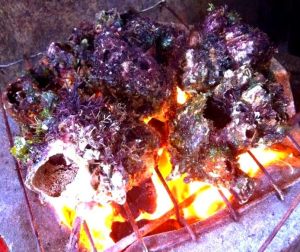Have you ever eaten something that looks disgusting but tastes super yummy?
Maybe bugs or insects? Animal innards? Fungi? Weeds? Or other strange looking foods?
I have my own experience of eating an unusual but really delicious food – a Sea Barnacle, known in our hometown as ronoron. At first it looks just like a rough rock covered in little seaweeds, but as you look closer, you will see that it contains holes that are filled with “organisms” which move – just a little movement, enough to make you realize that whatever’s inside that rock is alive. Sometimes you can see tiny bubbles coming out of those holes, which are actually the air expelled by such organisms inside. So this rock is actually a shell, a casing, a house, a habitat of a living creature.
Here’s How To Cook It
What’s nice about this food is that it is very easy to cook. You just need FIRE. Grill ronoron until it all turns dark brown (burnt brown) or black.
You’ll also notice water seething from it. This indicates that the “creatures” inside are getting cooked. And oh that smell of fresh seafood being cooked. It only takes a while to get this food cooked but that does not end there.
What You Need Before You Eat
Ronoron is easy to cook but it takes quite an effort to eat it. Why? How do you suppose you’re going to eat what’s inside the rocky shell? You’re gonna need to hammer it. You may use a rock or a metal, or a hammer 🙂 But be very careful when beating it as the shell debris may fly and hit your eyes. You also do not want the flesh inside to get crushed and be embedded with broken shells. That’s why you need to hit it carefully, just crack it enough to open it with your fingers and take the fleshy thing out.
The Fleshy “Thing”
The creature that I’ve been talking about from the beginning, those that live inside the rocky shell, is the prize for all the burns and cuts and all the efforts in preparing this meal. It is soft, juicy, peachy-white in color and very very tasty! You may eat it with rice or eat it as is while gulping some beer. 🙂
The Down Side of Something Special
What makes ronoron special is its rarity and the difficulty in getting it. You see, you cannot just drop a net and wait for it to come. You do not catch ronoron. Instead, you dive bringing your bolo or hammer and harvest it. It is simple but never easy. Some fishermen died doing this job. It’s like mining underwater in which efforts are doubled that way. You need more energy as you move and work underwater not to mention the limited supply of oxygen. Of course, after that, a sack of ronoron does not jump into the boat or raft by itself. You’ll have to swim up while carrying it. You’re lucky if the tide is low or the sea is calm.
The Socio-economic Aspect
So why do it? It’s risky!!!
First of all, since my hometown is a fishing village, the sea is the people’s primary source of income. Fishing requires not only a boat but other fishing paraphernalia such as nets, hooks, ropes, floaters, and of course, gasoline. You need gasoline so you can fish farther out in the sea where fish is more abundant.
If you’re just a small-time fisherman, who only manages a raft or a small boat with paddles instead of engines, you may fish nearby but there is no guarantee that you’ll get a lot. You may opt to harvest ronoron instead, considering season. If you’re lucky, you’ll have some.You may get sacks of it, you may get few, but there is one guarantee, that is, it costs more than a fish.
With its glorious taste, the demand is high and as a supplier, you also demand a higher price. One sack of ronoron can cost more or less a thousand. Imagine getting 2 sacks in a day. For a fisherman, that’s already good money given the fact that you didn’t spend some gasoline.
All risks are forgotten. Safety is set aside as long as you’ll bring home some money. This is the kind of thinking that got some ronoron harvesters killed.
The Environmental Impact
However, to this time, there are very few people who dive for ronoron. it’s not because they’ve been aware of the dangers of it, but because there are almost no more to dive for. Ronoron do not grow or increase rapidly. Much has been harvested everyday than has been reproduced. Imagine your backyard with growing camote vines. When you harvest the crops, it’ll take some time to regrow another batch again. Same with ronoron, only, it takes much more time. And unlike camote where the vines can produce crops again, if you get all the ronoron, they’ll have to start from scratch.
Due to the decreasing number of ronoron, the local officials proclaimed the prohibition of getting ronoron as it also creates a negative effect in the area’s marine life. Ronoron, as part of the sea, plays a role in the marine ecosystem, and with it being pulled out of its habitat is not good at all.
There are still some who get ronoron, but only few and very infrequent. It’s a shame actually, we have enjoyed its delectable taste, but upon realizing that every beating that breaks down the shell is also one deed of hitting mother nature is a wake up call. We felt bad about it. On the other hand, it is such a pride to know that people are cooperative in this law. In the end, it’s for our future.

